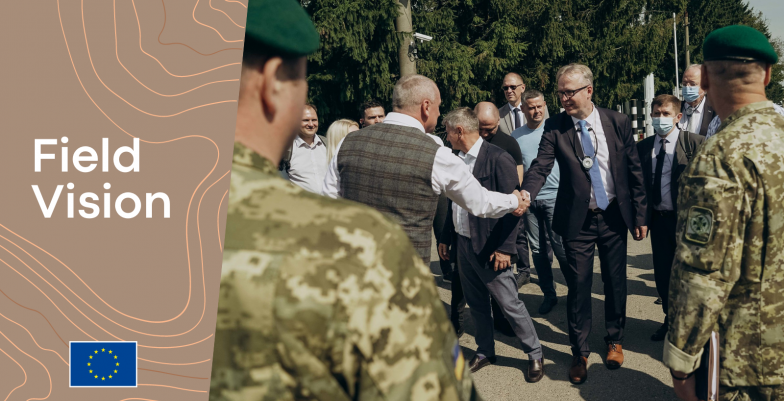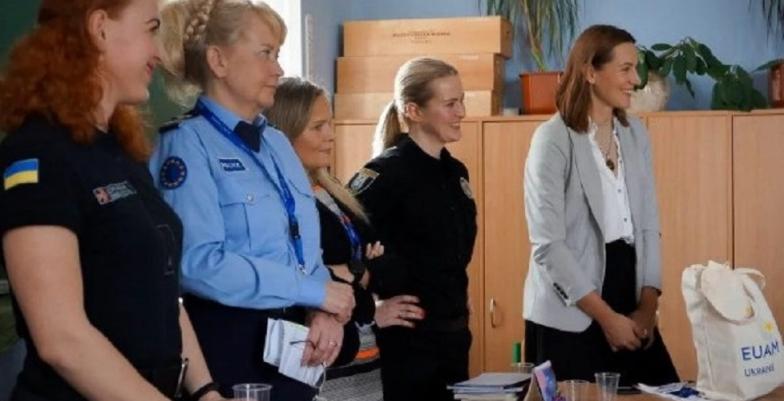EU military & defence support to Ukraine
Today, European security is indivisible from Ukraine’s security. This page outlines how the EU and Member States provide military support to Ukraine with large-scale training and investment.
EU in support of Ukraine`s defence
EU military support to Ukraine is critical for the country to defend its sovereignty, territorial integrity, freedom and independence against Russia’s war of aggression and be in a position of strength to reach peace.
To date, the EU and its Member States have provided €63.2 billion in military support to Ukraine:
- Providing military equipment: with the support from the European Peace Facility, the EU steadily supported Ukraine Armed Forces to address their pressing military and defence needs. Stepping up those efforts is a priority, in particular the delivery of air defence and anti-drone systems, as well as large-calibre ammunition. The EU has committed to supply Ukraine with two million rounds of ammunition in 2025.
- Training Ukrainian soldiers: thanks to the EU Military Assistance Mission in support of Ukraine – EUMAM – which was launched in 2022, more than 80,000 Ukrainian soldiers to date were trained and equipped. Training ranges from CBRN (chemical, biological, radiological, nuclear) defence to tactical planning and manoeuvre preparation.
- Supporting Ukraine’s defence industry: in line with European Council conclusions, the White Paper for European Defence – Readiness 2030 underlined the importance of further supporting and developing Ukraine’s defence industry and its cooperation and integration with the European defence industry.
- Robust security commitments: signed on 27 June 2024, joint EU-Ukraine security commitments include predictable, long-term and sustainable support for Ukraine’s security and defence.
The EU support is provided in close coordination with our partners, such as NATO.
Money for Ukrainian defence
€63.2 billion in military support to Ukraine provided by the EU and Member States
This includes:
• €6.1 billion from the European Peace Facility
In addition:
• Windfall profits – extraordinary revenues generated from Russian immobilised assets for an amount of €3.4 billion, out of which €1.5 billion were invested into the Ukrainian defence industry.
- Follow the link to download the European Security Starts in Ukraine infographic.
Military assistance to Ukraine
Since the very first days of Russia’s full-scale invasion in February 2022, the EU and its Member States have provided military support to Ukraine. This was made possible also thanks to the rapid mobilisation of the European Peace Facility, an off-budget instrument which has allowed to fund the provision of military and defence equipment to Ukraine’s Armed Forces.
Through the European Peace Facility, the EU finances the provision of lethal and non‑lethal military equipment and supplies, such as:
- personal protective equipment
- personnel carriers
- air defence assets
- artillery systems, ammunition and missiles.
- tanks
- ambulances
- first aid kits
- fuel
This has enhanced the capacity of Ukraine to defend its sovereignty and territorial integrity. Norway has supported the EU measures with a contribution of €122 million.
In addition, in March 2024, the EU decided to increase the financial ceiling of the European Peace Facility by €5 billion, by establishing a dedicated Ukraine Assistance Fund.
- Follow the link to read more about the European Peace Facility
Training Ukrainian personnel
Since 2022, more than 80 000 Ukrainian soldiers have been trained by the EU Military Assistance Mission in support of Ukraine – EUMAM Ukraine.
The Mission, now extended until 15 November 2026, is a direct response to Ukraine's request for support. It is mandated to provide:
- individual, collective and specialised training for Ukraine's Armed Forces
- coordination and synchronisation of Member States' activities delivering the training
EUMAM Ukraine covers a wide range of training, for example:
- Medical assistance
- CBRN (chemical, biological, radiological, nuclear) defence
- Demining
- Logistics and communication
- Tactical planning and manoeuvre preparation, or
- Live-fire exercise coordination
The Mission works closely together with like-minded international partners. EUMAM Ukraine is open to participation by non-EU countries.
Financial support for EUMAM Ukraine is covered under the European Peace Facility.
- As of 11 November 2024, it has totalled €382 million, including €140.2 million for the provision of lethal and non‑lethal training equipment to trained soldiers.
- An additional €409 million were allocated for two more years (November 2024 - November 2026) following the EUMAM extension.
- Norway has supported the mission with a voluntary contribution of €14 million.
Follow the link to learn more about the EU Military Assistance Mission in support of Ukraine.
Strengthening Ukrainian Defence industry
Strengthening the Ukrainian defence industry is an important dimension of the EU support. Ukraine can often produce necessary military equipment faster, cheaper and closer to the battlefield.
Ukraine’s industry has increased its production and innovation capacity and is best positioned to respond to their pressing military and defence needs, provided that funding is available.
To this end, the EU has already invested €1.5 billion from extraordinary revenue from Russian immobilised assets to support Ukraine’s own defence industry by buying military equipment for Ukraine from Ukrainian industry. This makes the EU the largest foreign public investor in Ukraine’s defence industry.
More and more, Ukraine’s defence industry will be closely associated to European defence initiatives and collaborative projects, including with the support from the Security Action for Europe (SAFE) instrument as well as the European Defence Industry Programme (EDIP). This will help to progressively integrate Ukraine’s defence industry into the European defence technological and industrial base. This is also one of the objectives of the first European Defence Industrial Strategy adopted in 2024 (EDIS).
Investing in Ukraine`s security
To reach this goal, the EU:
- Holds regular EU-Ukraine defence industry forums where our companies meet and where matchmaking is facilitated.
- Inaugurated an EU defence innovation office in Kyiv, which since 2024 helps develop cooperation and encourages joint ventures between Ukrainian and European companies.
- EU-Ukraine Task Force on Defence Industrial Cooperation convenes regularly at political and technical level to bring cooperation forward.
- Encourages the participation of Ukraine in the projects under the European Defence Fund.
- Introduced The BraveTech EU initiative, aimed at accelerating defence innovation through closer cooperation.
- Cooperates with Ukraine in the context of the European Defence Agency efforts to improve Member States’ defence capabilities through European cooperation,
Working closely with Ukraine brings benefits to the EU and Member States: learning from Ukraine’s outstanding innovation capacities and ability to quickly ramp up production, it can help strengthen our European defence industry.
Investing in Ukraine’s security is investing in Europe’s security.
Meeting the most pressing defence needs
The EU support is focused on Ukraine’s most pressing needs, especially air defence and anti-drone systems, as well as large-calibre ammunition.
- The HR/VP Kaja Kallas launched an EU goal of supplying Ukraine with two million rounds of large-calibre ammunition in 2025. 25 Member States actively participate in the provision of ammunition to Ukraine under this initiative. In addition, Norway will support the acquisition of ammunition in support of this initiative for a total value of €84.4 million.
- Through previous initiatives, such as the ammunition and missiles plan agreed by the Council in 2023, the EU has encouraged and supported the provision and joint procurement by EU Member States and Norway of ammunition and missiles for Ukraine. This includes funding worth €2 billion from the European Peace Facility.
- The EU has also increased and accelerated its production capacity of ammunitions and missiles, following the adoption of the Act in Support to Ammunition Production (ASAP) regulation on 20 July 2023, mobilising €500 million from the EU budget to support the ramping up of manufacturing capacities. It supports industrial reinforcement throughout the supply chains of ammunition and missiles in the EU and helps Member States refill their stocks by introducing targeted measures.
- In May 2024, the Council adapted the legal framework to ensure that the extraordinary revenues generated from immobilised Russian assets in the EU – also known as ‘windfall profits’- can be used to support Ukraine. Via the European Peace Facility, €3.3 billion in 2024 and 2025 were allocated to accelerate Ukraine’s production of military equipment, from artillery and air defence systems to drones. Extraordinary revenues will also be allocated to the EU budget and channelled through the Ukraine Loan Cooperation Mechanism, an instrument created by the EU to help Ukraine repay EU-G7 loans of around €45 billion. Follow the link to learn more about Russia's frozen assets in Europe.
Joint security commitments
On 27 June 2024, the EU and Ukraine signed Joint security commitments. These commitments will help Ukraine to defend itself, resist destabilisation efforts and deter acts of aggression.
The EU security commitments build on existing support and encompass predictable, long-term and sustainable support for Ukraine’s security and defence – notably through the common security and defence policy missions, as well as wider security commitments.
Ukraine commits to continue undertaking reforms. In line with its path towards the EU, Ukraine will continue to strengthen transparency and accountability measures and to contribute to the security of the EU.
Beyond military support
While military support is essential, the EU’s assistance to Ukraine goes far beyond:
- A civilian mission under the Common Security and Defence Policy, the EU Assistance Mission in Ukraine, is deployed in the country since 2014.
- The EU also provides emergency macro-financial assistance, budget support, humanitarian aid, civil protection support, and support in investigation and prosecution of war crimes – among others.
- To date, the EU has provided Ukraine with support amounting to €158.6 billion.
Follow the link to learn more about the comprehensive and wide-ranging EU support measures










